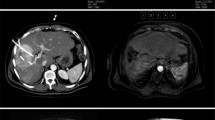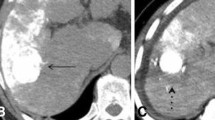Abstract
Purpose
The purpose of the study was to evaluate safety, time to recurrence, and overall survival (OS) in patients with liver metastases (LM), treated with transarterial chemoembolization (TACE) followed by ablation.
Materials and methods
This retrospective study included all patients with LM treated with combined TACE and ablation from August 1998 to September 2015. Forty-two patients (12 women, 30 men; age 62.9 ± 11.9 years) were treated for 44 LMs. Tumor characteristics, imaging response to treatment, recurrence, and OS data were reviewed. Statistical analysis included Kaplan–Meier estimation, Cox regression and Fisher’s exact, Wilcoxon rank sum, or log rank tests.
Results
Median follow-up was 10.3 months. Eighteen patients had 1 hepatic lesion, 16 had 2–5, and 8 had > 5. Median index lesion size was 4.7 cm (range 1.5–8 .0 cm). Tumor response (mRECIST) was available for 41/44 treated lesions, with CR in 32 (78.0%), PR in 8 (19.5%), and PD in 1 (2.4%). Long-term imaging follow-up was available for 38 patients. Freedom from local recurrence was 61% at 1 year and 50% at 2 years. OS was 55% at 1 year and 30% at 2 years (median OS, 14.5 months). Tumor size and histology were not predictors of time to progression or OS. Complications occurred in 19 patients (45%). Major complications occurred in 19% of patients and included hospitalization for fever (n = 2), hepatic abscess (n = 3) and fall requiring transfusion, portal vein thrombus causing lobar infarct, biliary fistula, and retroperitoneal hematoma (n = 1 each).
Conclusions
Combined TACE and ablation is effective for local tumor control of liver metastases up to 8 cm when part of a multidisciplinary treatment strategy. Major complications occurred in 19% of patients.





Similar content being viewed by others
References
Imam K, Bluemke DA (2000) MR imaging in the evaluation of hepatic metastases. Magn Reson Imaging Clin N Am 8(4):741–756
Ravikumar TS, Gallos G (2002) Resection of liver metastases: state of the art. Oncology (Williston Park) 16(9):1240–1256; discussion 1258–1260, 1263
Assy N, Nasser G, Djibre A, et al. (2009) Characteristics of common solid liver lesions and recommendations for diagnostic workup. World J Gastroenterol 15(26):3217–3227
Blumgart LH, Allison DJ (1982) Resection and embolization in the management of secondary hepatic tumors. World J Surg 6(1):32–45
Harrison LE, Brennan MF, Newman E, et al. (1997) Hepatic resection for noncolorectal, nonneuroendocrine metastases: a fifteen-year experience with ninety-six patients. Surgery 121(6):625–632
Page AJ, Weiss MJ, Pawlik TM (2014) Surgical management of noncolorectal cancer liver metastases. Cancer 120(20):3111–3121. https://doi.org/10.1002/cncr.28743
Schwartz SI (1995) Hepatic resection for noncolorectal nonneuroendocrine metastases. World J Surg 19(1):72–75
Llovet JM, Real MI, Montana X, et al. (2002) Arterial embolisation or chemoembolisation versus symptomatic treatment in patients with unresectable hepatocellular carcinoma: a randomised controlled trial. Lancet 359(9319):1734–1739. https://doi.org/10.1016/S0140-6736(02)08649-X
Lo CM, Ngan H, Tso WK, et al. (2002) Randomized controlled trial of transarterial lipiodol chemoembolization for unresectable hepatocellular carcinoma. Hepatology 35(5):1164–1171. https://doi.org/10.1053/jhep.2002.33156
Takayasu K, Arii S, Ikai I, Omata M, Okita K, Ichida T, Matsuyama Y, Nakanuma Y, Kojiro M, Makuuchi M, Yamaoka Y, Liver Cancer Study Group of J (2006) Prospective cohort study of transarterial chemoembolization for unresectable hepatocellular carcinoma in 8510 patients. Gastroenterology 131(2):461–469. https://doi.org/10.1053/j.gastro.2006.05.021
Kagawa T, Koizumi J, Kojima S, et al. (2010) Transcatheter arterial chemoembolization plus radiofrequency ablation therapy for early stage hepatocellular carcinoma: comparison with surgical resection. Cancer 116(15):3638–3644. https://doi.org/10.1002/cncr.25142
Veltri A, Moretto P, Doriguzzi A, et al. (2006) Radiofrequency thermal ablation (RFA) after transarterial chemoembolization (TACE) as a combined therapy for unresectable non-early hepatocellular carcinoma (HCC). Eur Radiol 16(3):661–669. https://doi.org/10.1007/s00330-005-0029-9
Bholee AK, Peng K, Zhou Z, et al. (2017) Radiofrequency ablation combined with transarterial chemoembolization versus hepatectomy for patients with hepatocellular carcinoma within Milan criteria: a retrospective case-control study. Clin Transl Oncol . https://doi.org/10.1007/s12094-016-1611-0
Peng ZW, Zhang YJ, Chen MS, et al. (2013) Radiofrequency ablation with or without transcatheter arterial chemoembolization in the treatment of hepatocellular carcinoma: a prospective randomized trial. J Clin Oncol 31(4):426–432. https://doi.org/10.1200/JCO.2012.42.9936
Wu ZB, Si ZM, Qian S, et al. (2016) Percutaneous microwave ablation combined with synchronous transcatheter arterial chemoembolization for the treatment of colorectal liver metastases: results from a follow-up cohort. Onco Targets Ther 9:3783–3789. https://doi.org/10.2147/OTT.S105192
Fong ZV, Palazzo F, Needleman L, et al. (2012) Combined hepatic arterial embolization and hepatic ablation for unresectable colorectal metastases to the liver. Am Surg 78(11):1243–1248
Kan XF, Wang Y, Lin GC, et al. (2016) Radiofrequency ablation combined with transarterial chemoembolization for liver metastases from gastrointestinal cancers. J Huazhong Univ Sci Technolog Med Sci 36(2):200–204. https://doi.org/10.1007/s11596-016-1566-y
Charnsangavej C (1993) Chemoembolization of Liver Tumors. Semin intervent Radiol 10(2):150–160. https://doi.org/10.1055/s-2008-1074718
Gee M, Soulen MC (2002) Chemoembolization for hepatic metastases. Tech Vasc Interv Radiol 5(3):132–140. https://doi.org/10.1053/tvir.2002.36422
Eisenhauer EA, Therasse P, Bogaerts J, et al. (2009) New response evaluation criteria in solid tumours: revised RECIST guideline (version 1.1). Eur J Cancer 45(2):228–247. https://doi.org/10.1016/j.ejca.2008.10.026
Social Security Death Index. http://ssdi.genealogy.rootsweb.com/. Accessed September 16, 2016
Omary RA, Bettmann MA, Cardella JF, Bakal CW, Schwartzberg MS, Sacks D, Rholl KS, Meranze SG, Lewis CA, Society of Interventional Radiology Standards of Practice C (2003) Quality improvement guidelines for the reporting and archiving of interventional radiology procedures. J Vasc Interv Radiol 14(9 Pt 2):S293–S295
Kim JH, Won HJ, Shin YM, et al. (2011) Medium-sized (3.1-5.0 cm) hepatocellular carcinoma: transarterial chemoembolization plus radiofrequency ablation versus radiofrequency ablation alone. Ann Surg Oncol 18(6):1624–1629. https://doi.org/10.1245/s10434-011-1673-8
Morimoto M, Numata K, Kondou M, et al. (2010) Midterm outcomes in patients with intermediate-sized hepatocellular carcinoma: a randomized controlled trial for determining the efficacy of radiofrequency ablation combined with transcatheter arterial chemoembolization. Cancer 116(23):5452–5460. https://doi.org/10.1002/cncr.25314
Alexander ES, Soulen MC (2016) Liver metastases from noncolorectal malignancies (neuroendocrine tumor, sarcoma, melanoma, breast). Cancer J 22(6):381–386. https://doi.org/10.1097/PPO.0000000000000232
Vasnani R, Ginsburg M, Ahmed O, et al. (2016) Radiofrequency and microwave ablation in combination with transarterial chemoembolization induce equivalent histopathologic coagulation necrosis in hepatocellular carcinoma patients bridged to liver transplantation. Hepatobiliary Surg Nutr 5(3):225–233. https://doi.org/10.21037/hbsn.2016.01.05
Kwan SW, Fidelman N, Ma E, Kerlan RK Jr, Yao FY (2012) Imaging predictors of the response to transarterial chemoembolization in patients with hepatocellular carcinoma: a radiological-pathological correlation. Liver Transpl 18(6):727–736. https://doi.org/10.1002/lt.23413
Yang P, Zeng ZC, Wang BL, et al. (2016) The degree of lipiodol accumulation can be an indicator of successful treatment for unresectable hepatocellular carcinoma (HCC) patients - in the case of transcatheter arterial chemoembolization (TACE) and external beam radiotherapy (EBRT). J Cancer 7(11):1413–1420. https://doi.org/10.7150/jca.15405
Moertel CG (1987) Karnofsky memorial lecture. An odyssey in the land of small tumors. J Clin Oncol 5(10):1502–1522. https://doi.org/10.1200/JCO.1987.5.10.1502
Shibata T, Isoda H, Hirokawa Y, et al. (2009) Small hepatocellular carcinoma: is radiofrequency ablation combined with transcatheter arterial chemoembolization more effective than radiofrequency ablation alone for treatment? Radiology 252(3):905–913. https://doi.org/10.1148/radiol.2523081676
Peng ZW, Chen MS, Liang HH, et al. (2010) A case-control study comparing percutaneous radiofrequency ablation alone or combined with transcatheter arterial chemoembolization for hepatocellular carcinoma. Eur J Surg Oncol 36(3):257–263. https://doi.org/10.1016/j.ejso.2009.07.007
Kim W, Clark TW, Baum RA, Soulen MC (2001) Risk factors for liver abscess formation after hepatic chemoembolization. J Vasc Interv Radiol 12(8):965–968
Welch BT, Schmitz JJ, Atwell TD, et al. (2017) Evaluation of infectious complications following percutaneous liver ablation in patients with bilioenteric anastomoses. Abdom Radiol (NY) 42(5):1579–1582. https://doi.org/10.1007/s00261-017-1051-5
Yu MA, Liang P, Yu XL, et al. (2011) Liver abscess as a complication of microwave ablation for liver metastatic cholangiocarcinoma after bilioenteric anastomosis. Int J Hyperthermia 27(5):503–509. https://doi.org/10.3109/02656736.2011.555876
Acknowledgments
Abramson Cancer Center Support Grant P30-CA016520 (RM)
Author information
Authors and Affiliations
Corresponding author
Ethics declarations
Conflict of interest
Dr. Stavropoulos has received research grants from Silajen and Cook; he is also a consultant for Bard. Dr. Soulen has received research grants from Guerbet LLC and BTG International; he is a consultant for Merit Medical, Terumo Medical, Bayer and Guerbet LLC; he is a proctor for Sirtex medical. Dr. Alexander declares that she has no conflict of interest. Prof. Mick declares that she has no conflict of interest. Dr. Nadolski declares that she has no conflict of interest. Dr. Mondschein declares that she has no conflict of interest.
Funding
This study was funded by an Abramson Cancer Center Support Grant P30-CA016520.
Ethical approval
All procedures performed in studies involving human participants were in accordance with the ethical standards of the institutional and/or national research committee and with the 1964 Helsinki declaration and its later amendments or comparable ethical standards. This article does not contain any studies with animals performed by any of the authors.
Informed consent
Institutional review board approval was obtained for this Health Insurance Portability and Accountability Act-compliant study. Informed consent was waived because of the retrospective nature of the study.
Rights and permissions
About this article
Cite this article
Alexander, E.S., Mick, R., Nadolski, G.J. et al. Combined chemoembolization and thermal ablation for the treatment of metastases to the liver. Abdom Radiol 43, 2859–2867 (2018). https://doi.org/10.1007/s00261-018-1536-x
Published:
Issue Date:
DOI: https://doi.org/10.1007/s00261-018-1536-x




